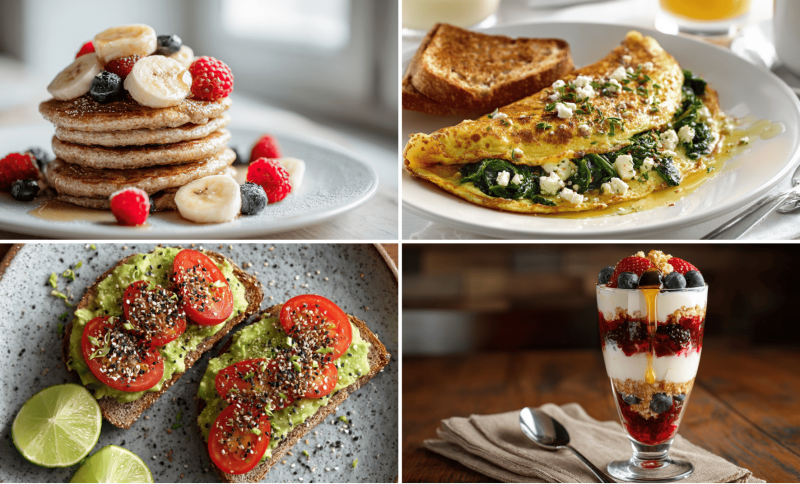Taking care of your brain health has never been more important or tasty. Mind diet recipes offer the perfect solution by combining flavorful meals with powerful brain-protecting nutrients.
The MIND diet emphasizes foods such as leafy greens, berries, nuts, fish, and whole grains that help maintain a sharp memory and support cognitive function.
These simple recipes make it easy to eat for better brain health every day.
From quick breakfast options to satisfying dinners, you’ll find how enjoyable healthy eating can be. Here are these brain-boosting mind diet recipes that will nourish your body and mind while tasting absolutely delicious.
What is the MIND Diet?
The MIND diet is a special eating plan that combines the best parts of two popular diets: the Mediterranean diet and the DASH diet.
MIND stands for “Mediterranean-DASH Intervention for Neurodegenerative Delay,” indicating that it’s designed to help maintain brain health as you age.
This diet focuses on foods that scientists believe can protect your brain and improve memory. The main foods include dark, leafy greens like spinach, colorful berries, whole grains, nuts, olive oil, and lean proteins such as fish and chicken.
By regularly consuming these brain-healthy foods, you may help reduce your risk of memory problems and maintain a sharp mind. For readers who enjoy baking brain-healthy treats, you might also explore the best protein powder for baking to add extra protein to recipes like oatmeal pancakes or banana-based quick breads — a simple way to boost nutrition while keeping things delicious.
MIND Diet Breakfast Recipes
Starting your day with MIND diet foods sets you up for better brain health and steady energy. These breakfast recipes are packed with nutrients that support memory, focus, and cognitive function.
1. Blueberry Walnut Overnight Oats
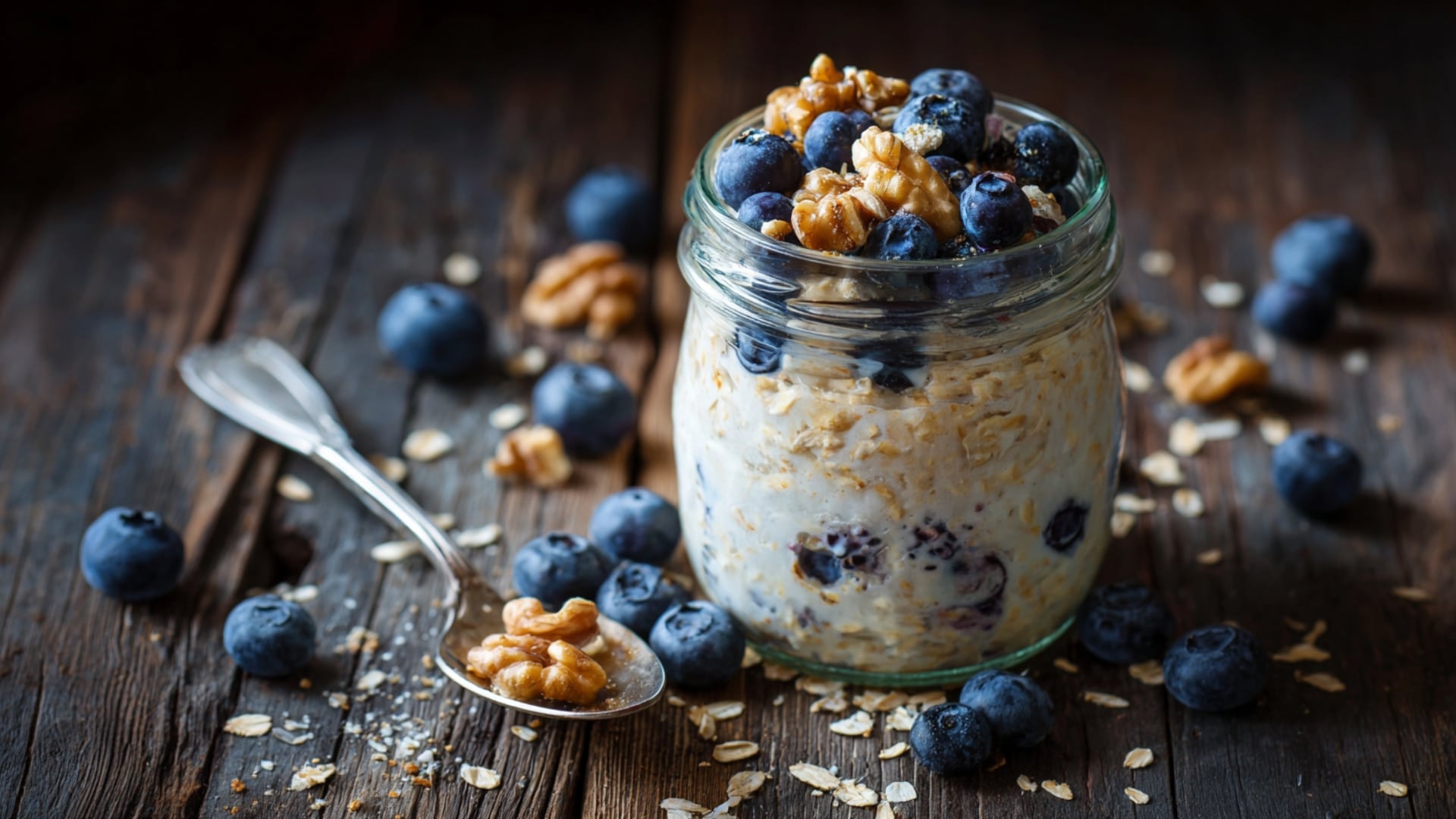
Start your morning with a brain-boosting breakfast that requires no cooking. These overnight oats combine fiber-rich oats with antioxidant-packed blueberries and omega-3-loaded walnuts.
The oats provide steady energy while blueberries help protect brain cells from damage. Walnuts add healthy fats that support memory and thinking skills. This make-ahead meal saves time on busy mornings.
Ingredients: Rolled oats, almond milk, chopped walnuts, blueberries, and honey.
Mini Recipe: Mix 1/2 cup oats, 1/2 cup almond milk, 1 tbsp chopped walnuts, and 1/4 cup blueberries in a jar. Add honey, stir well, and refrigerate overnight. Enjoy a cold, creamy breakfast.
2. Spinach and Feta Omelette (with Olive Oil)
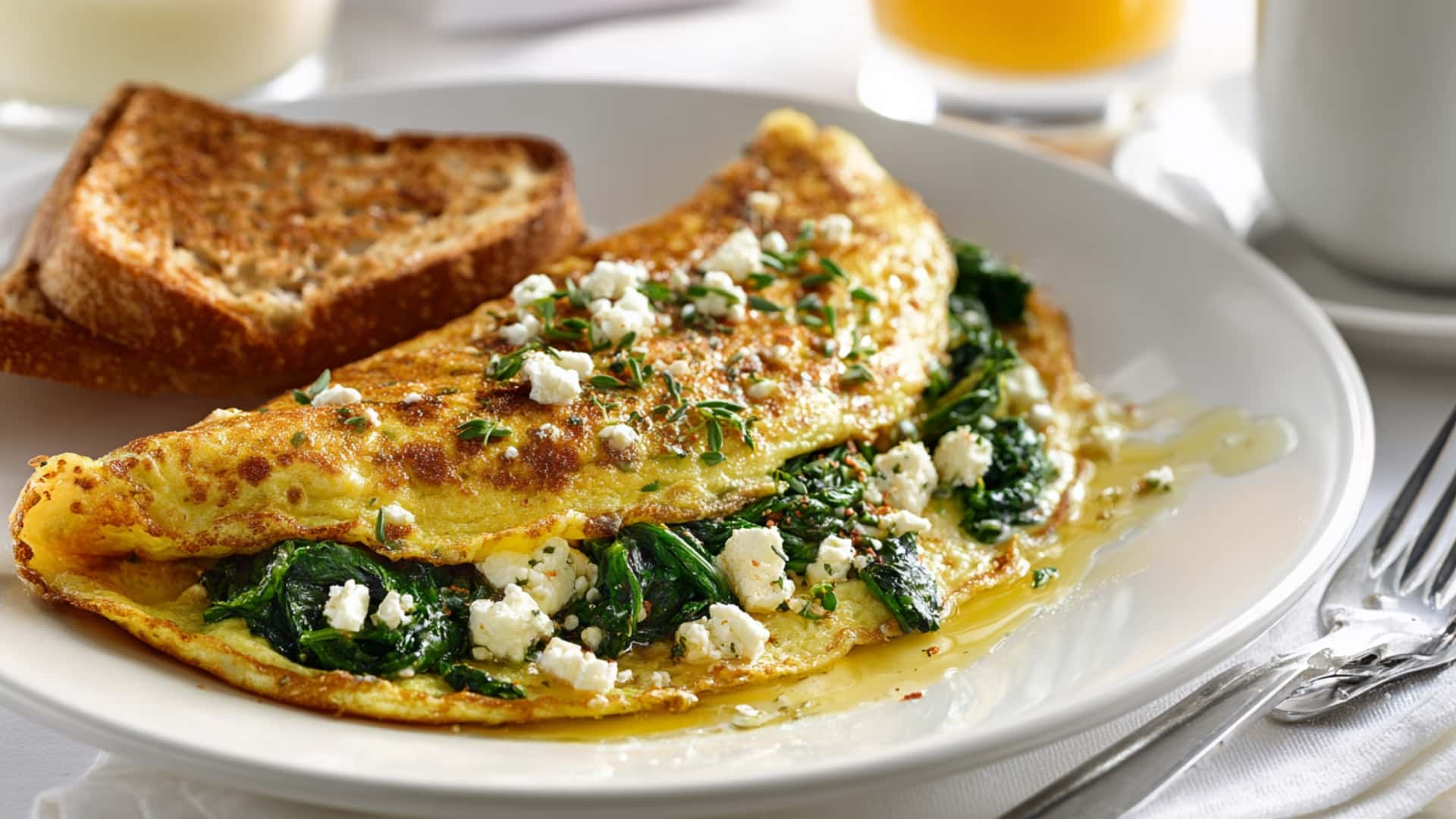
This protein-packed omelette delivers leafy greens and healthy fats in one delicious meal. Spinach provides folate and vitamin K, which support brain function.
Feta cheese adds calcium and protein, while olive oil gives you heart-healthy fats. Eggs contain choline, a nutrient that helps with memory. This quick breakfast takes just minutes to make and keeps you full for hours.
Ingredients: Eggs, fresh spinach, feta cheese, and olive oil.
Mini Recipe: Heat 1 tbsp olive oil in a pan. Whisk 2 eggs and pour them into the pan. Add a handful of spinach and 2 tbsp feta cheese. Cook until set, fold in half, and serve hot.
3. Chia Pudding with Almond Milk and Berries
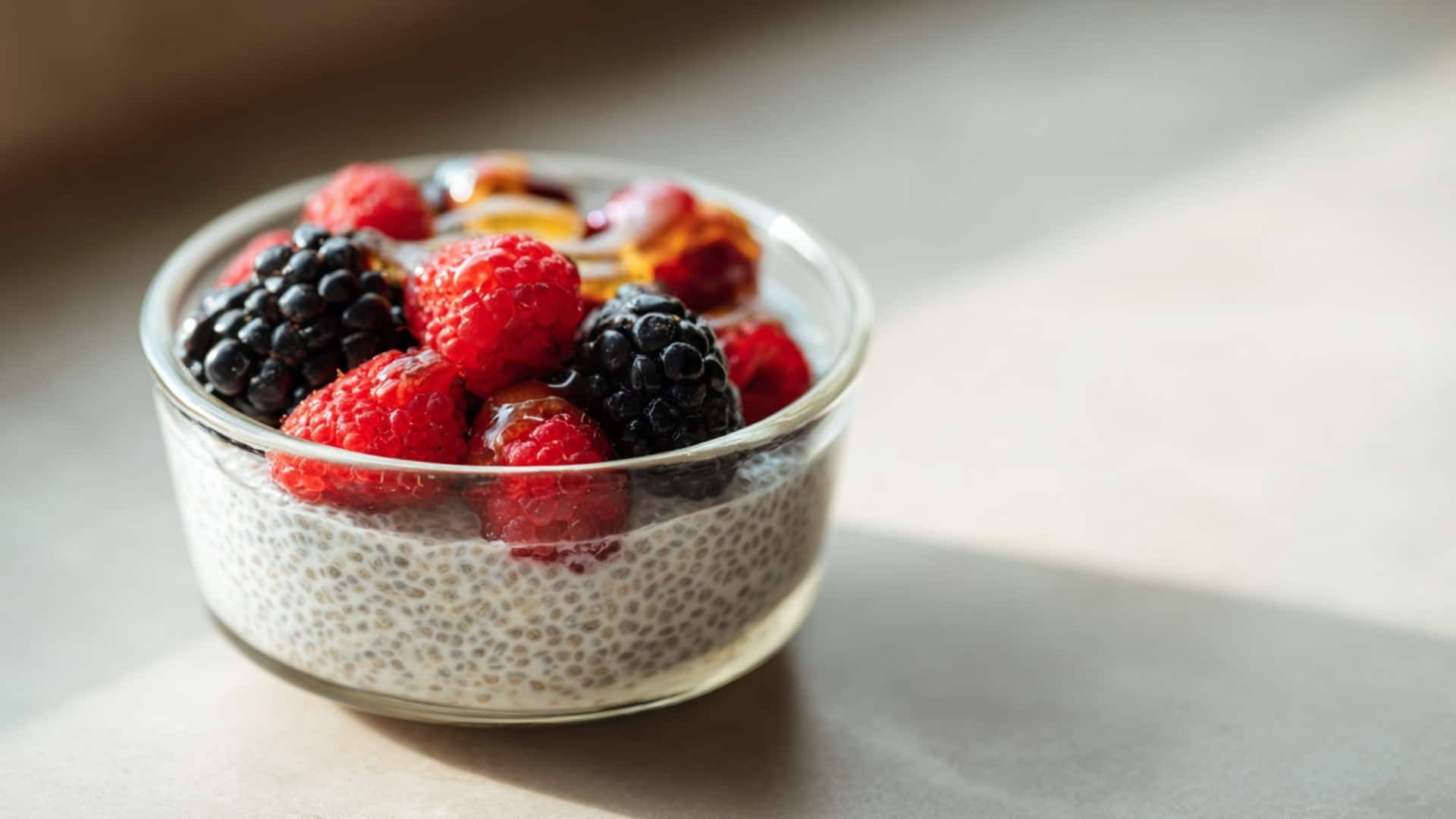
Tiny chia seeds pack a powerful punch of omega-3 fatty acids and fiber. When soaked overnight, they create a creamy pudding texture that tastes great with berries.
Omega-3s help reduce brain inflammation, while berries provide antioxidants. Almond milk provides an additional source of nutrients without dairy. This no-cook breakfast is perfect for meal prep and busy schedules.
Ingredients: Chia seeds, almond milk, mixed berries, and honey.
Mini Recipe: Mix 3 tbsp chia seeds with 1 cup almond milk. Whisk well, wait 5 minutes, whisk again. Refrigerate overnight until thick. Top with mixed berries and honey before serving.
4. Avocado Toast on Whole Grain Bread
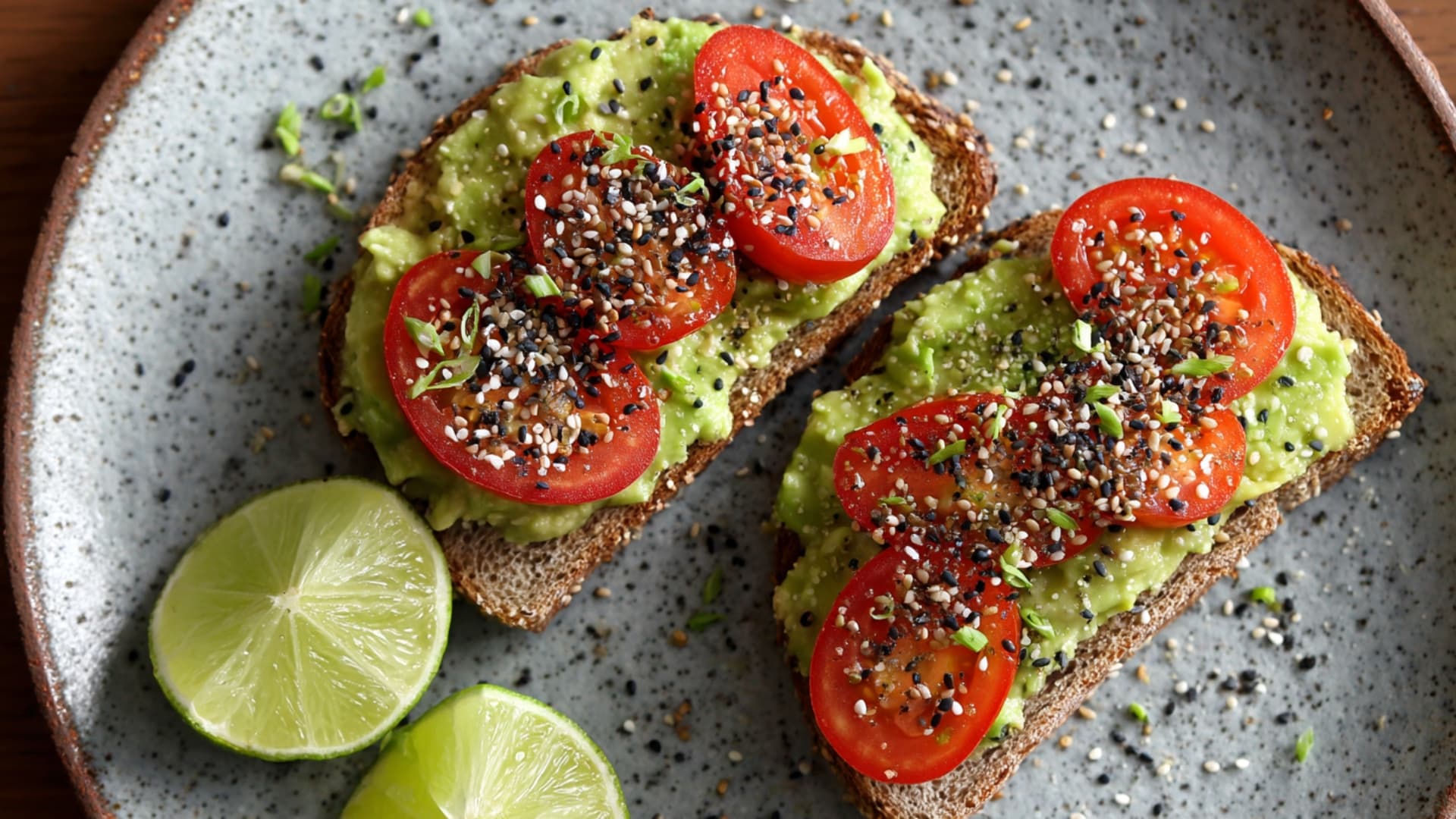
Avocados contain healthy monounsaturated fats that help blood flow to the brain. Paired with fiber-rich whole grain bread, this simple breakfast provides lasting energy.
The healthy fats help your body absorb fat-soluble vitamins, while the fiber keeps blood sugar steady. Add a sprinkle of salt and pepper for extra flavor. This trendy breakfast is both nutritious and satisfying.
Ingredients: Whole-grain bread, ripe avocado, lime juice, salt, pepper, and optional toppings such as tomato slices or additional seasonings.
Mini Recipe: Toast 2 slices of whole-grain bread. Mash 1/2 avocado with lime juice, salt, and pepper. Spread on toast and top with sliced tomatoes or sprinkle with everything bagel seasoning for added flavor.
5. Greek Yogurt Parfait with Berries and Flaxseeds
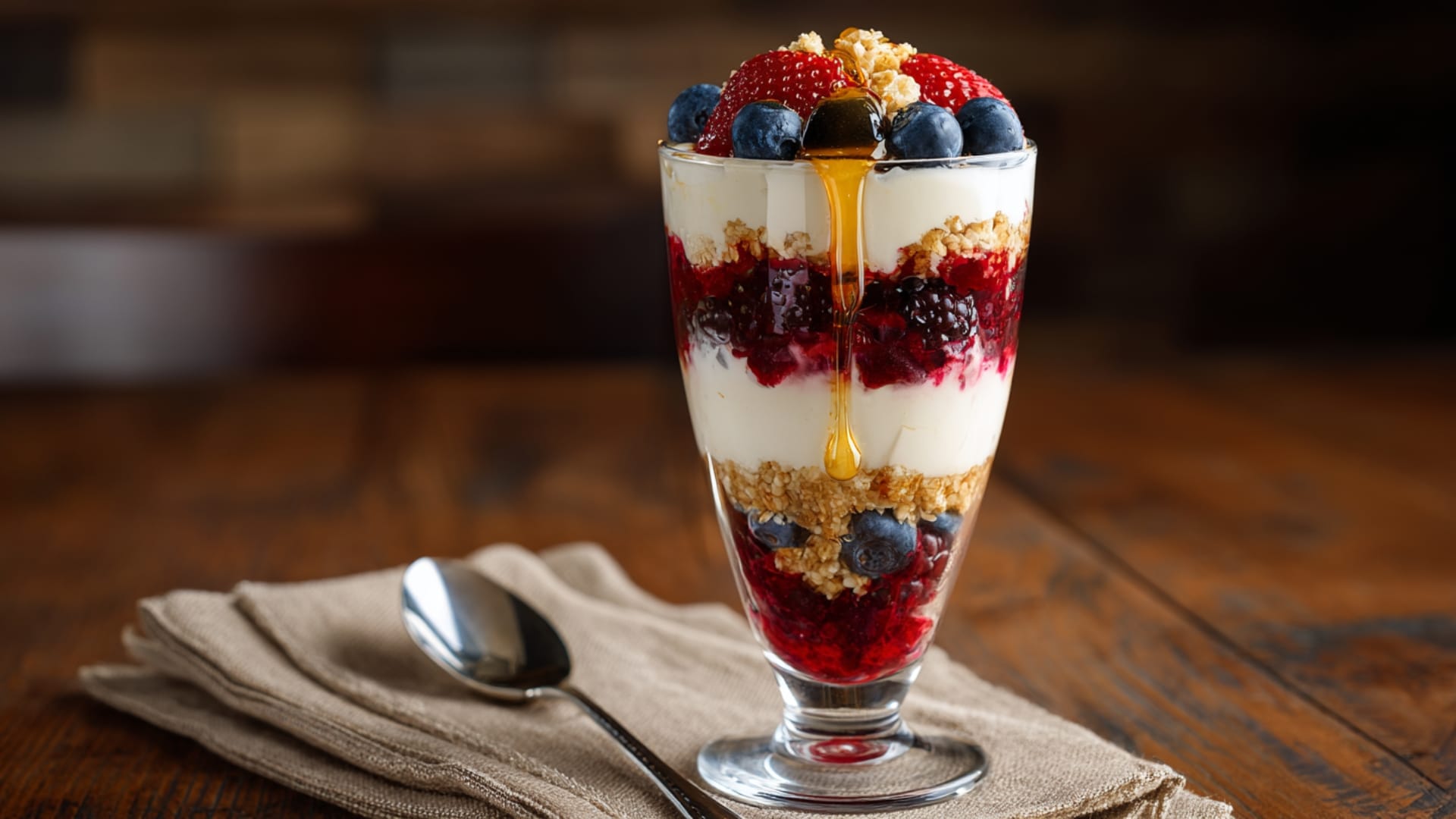
Greek yogurt provides probiotics that may help brain health through the gut-brain connection. Mixed berries add antioxidants that protect brain cells from damage.
Flaxseeds contribute omega-3 fatty acids and fiber for heart and brain health. This colorful breakfast looks as good as it tastes. Layer ingredients in a glass for an attractive presentation that kids will love.
Ingredients: Greek yogurt, fresh berries, ground flaxseeds, and honey.
Mini Recipe: Layer 1/2 cup Greek yogurt with 1/4 cup berries and 1 tbsp ground flaxseeds in a glass. Repeat the layers, then top with more berries and a drizzle of honey.
6. Banana Oat Pancakes (No Sugar Added)

These naturally sweet pancakes use banana instead of added sugar. Oats provide beta-glucan fiber that helps lower cholesterol and stabilize blood sugar.
Bananas add potassium and sweetness, and eggs supply protein. These fluffy pancakes taste great alone, but with fresh berries for extra antioxidants. Kids love these healthy, treat-like pancakes.
Ingredients: Banana, rolled oats, egg, and cinnamon.
Mini Recipe: Blend 1 banana, 1/2 cup oats, 1 egg, and cinnamon until smooth. Heat a non-stick pan and cook small pancakes for 2-3 minutes per side until golden brown.
7. Kale and Mushroom Breakfast Scramble
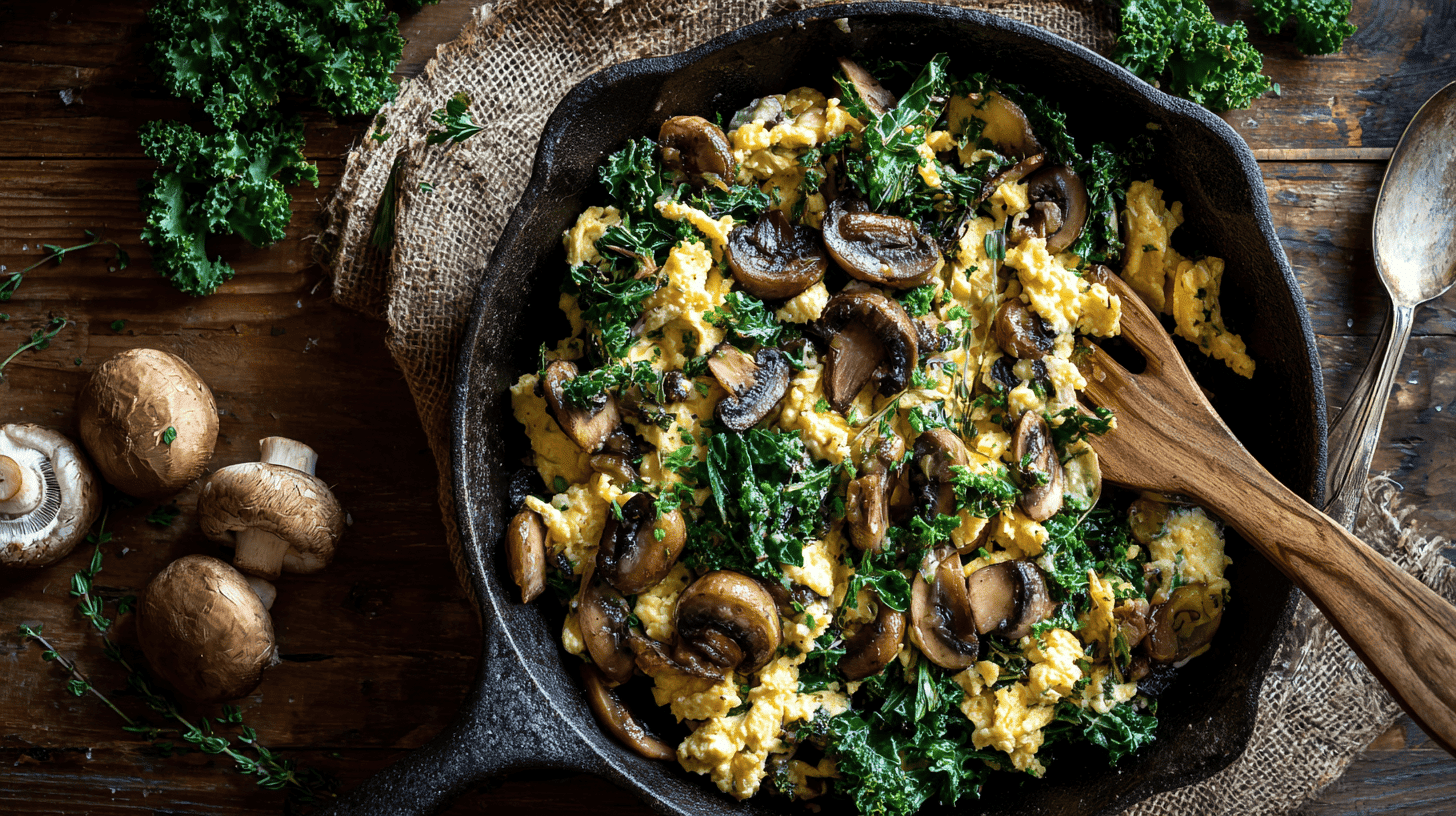
Kale is one of the most nutrient-dense leafy greens, packed with vitamins A, C, and K. Mushrooms provide important B vitamins that support brain function. This savory scramble works well with eggs or tofu for protein.
The combination of vegetables provides antioxidants and anti-inflammatory compounds. Cooking everything in one pan makes cleanup easy and saves time during busy mornings.
Ingredients: Eggs (or tofu), kale, mushrooms, olive oil, and herbs.
Mini Recipe: Sauté 1 cup chopped kale and 1/2 cup mushrooms in olive oil for 3 minutes. Add 2 beaten eggs, scramble until cooked. Season with salt, pepper, and herbs.
8. Apple-Cinnamon Quinoa Breakfast Bowl
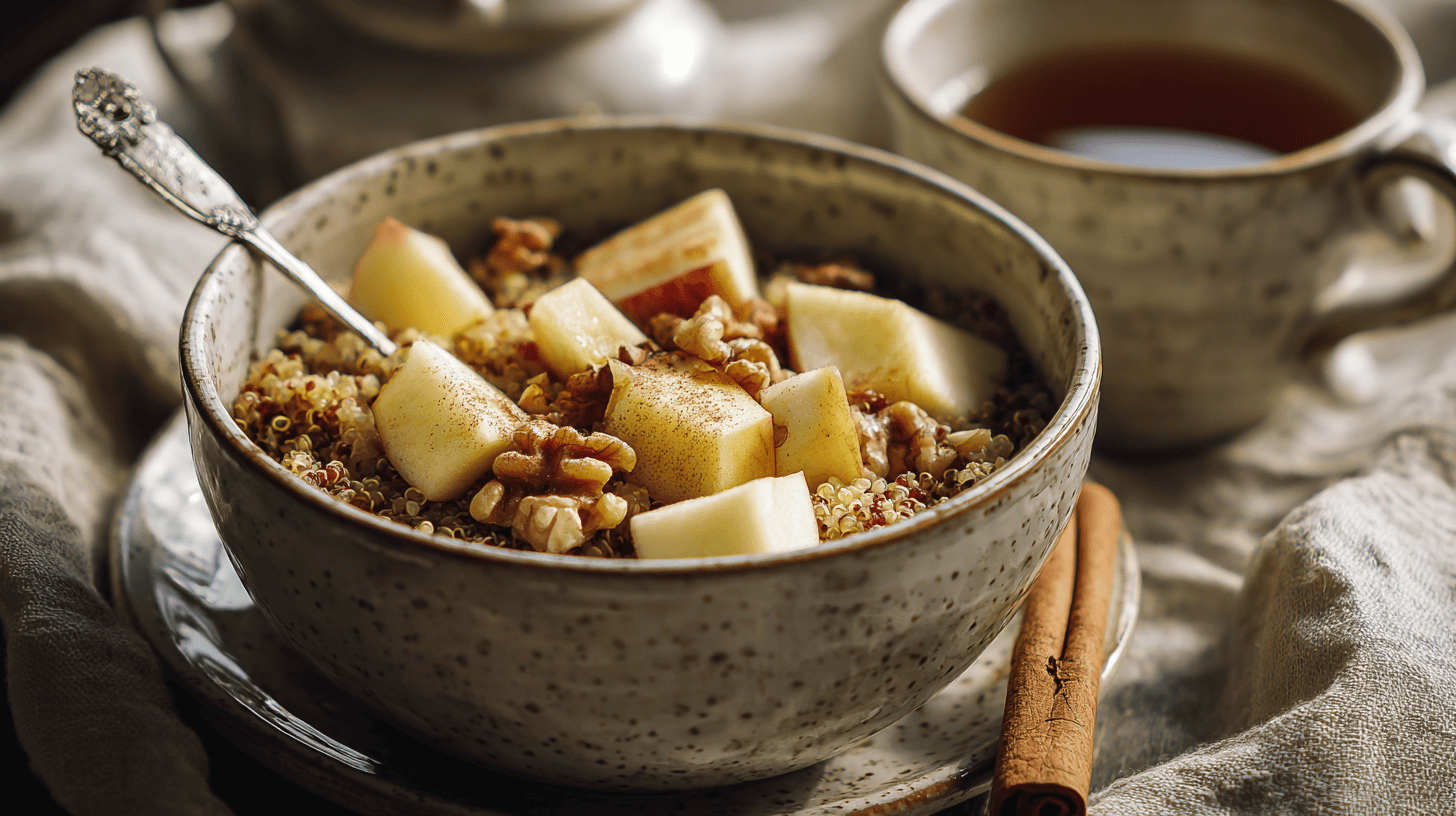
Quinoa is a complete protein that provides all the essential amino acids your brain needs. Apples add fiber and natural sweetness, while cinnamon may help improve memory and attention.
This warm breakfast bowl feels like a cozy treat while delivering serious nutrition. Quinoa cooks faster than oatmeal and has a pleasant nutty flavor. Add nuts or seeds for an extra boost of healthy fats.
Ingredients: Quinoa, almond milk, apple, cinnamon, and walnuts or almonds.
Mini Recipe: Cook 1/2 cup quinoa in 1 cup almond milk for 15 minutes. Add diced apple and cinnamon in the last 5 minutes. Top with chopped walnuts or almonds.
9. Berry Spinach Smoothie with Almond Butter
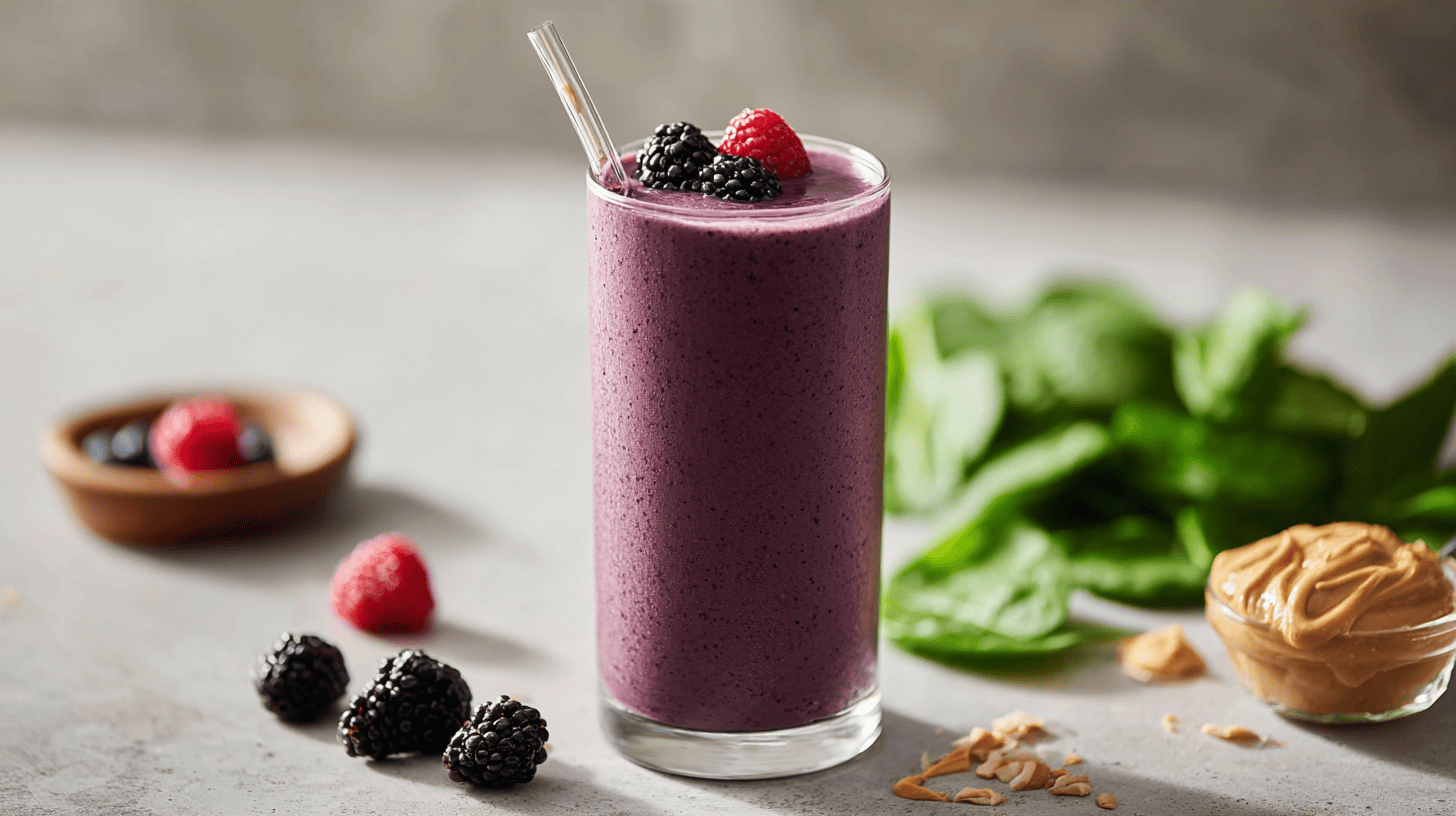
This purple smoothie hides leafy greens behind the sweet taste of berries. Spinach provides folate and iron, while berries add antioxidants that protect brain cells.
Almond butter contributes protein and healthy fats that help you feel full longer. The natural fruit sugars provide quick energy while the protein prevents blood sugar spikes. Blend well to ensure the spinach is completely smooth.
Ingredients: Frozen berries, spinach, almond butter, almond milk, and ice cubes (optional).
Mini Recipe: Blend 1 cup frozen berries, a handful of spinach, 2 tbsp almond butter, and 1 cup almond milk until smooth. Add ice cubes for extra thickness if needed.
Nourishing MIND Diet Lunch & Dinner Recipes
These lunch and dinner recipes bring together the best MIND diet ingredients for satisfying, brain-healthy meals. Each dish combines lean proteins, whole grains, and nutrient-rich vegetables that support cognitive function.
10. Grilled Salmon with Quinoa and Steamed Broccoli
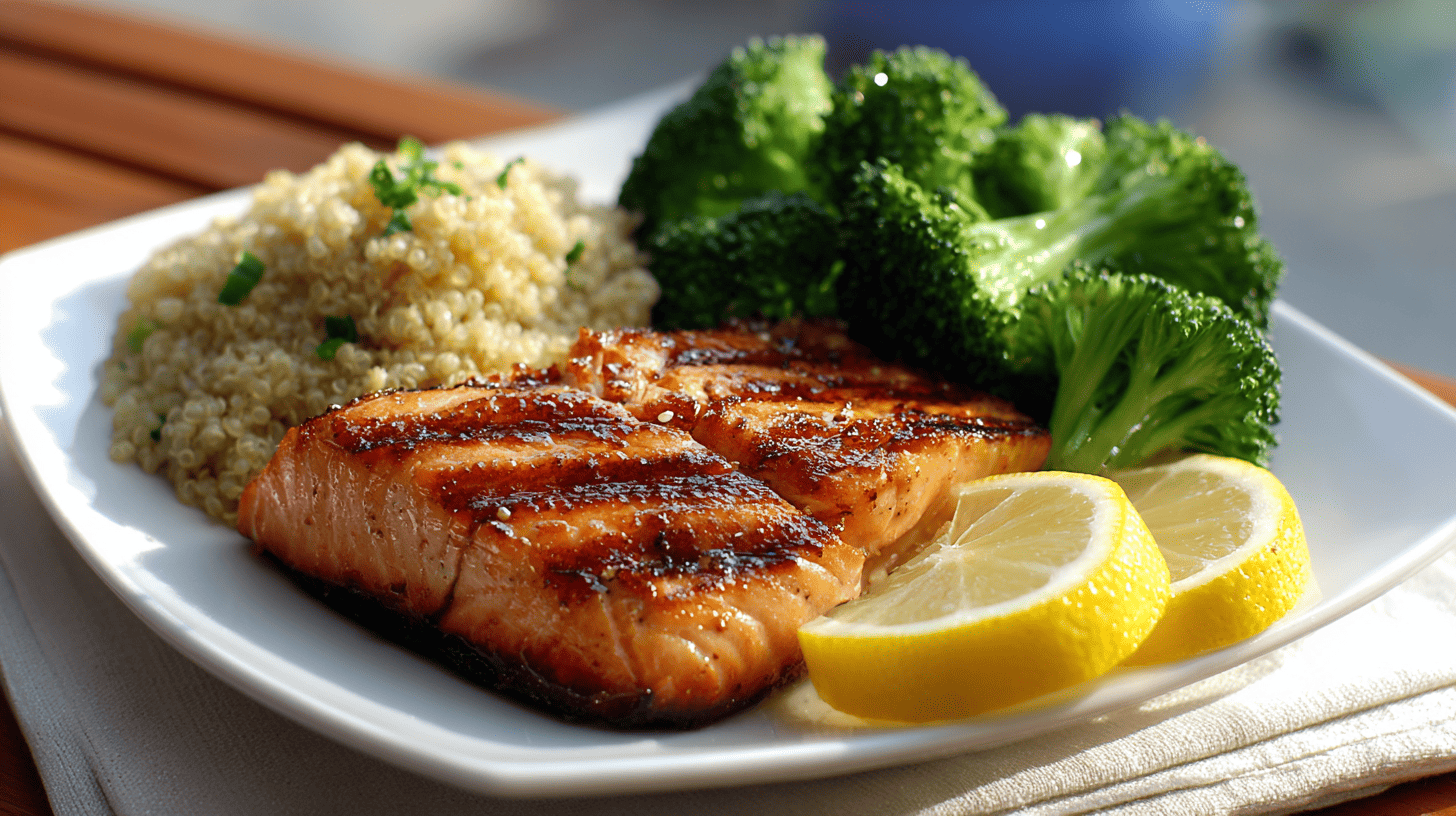
Salmon is one of the best sources of omega-3 fatty acids, which help reduce brain inflammation and support memory. Quinoa provides complete protein and fiber, while broccoli adds vitamin K and antioxidants.
This colorful meal delivers healthy fats, lean protein, and brain-boosting vegetables in one plate. The omega-3s in salmon may help protect against cognitive decline as you age.
Ingredients: Salmon fillets, quinoa, broccoli, olive oil, herbs, and lemon.
Mini Recipe: Season salmon with herbs and grill for 4-5 minutes per side. Cook quinoa according to package directions. Steam broccoli until tender and serve everything together with lemon.
11. Lentil and Kale Soup
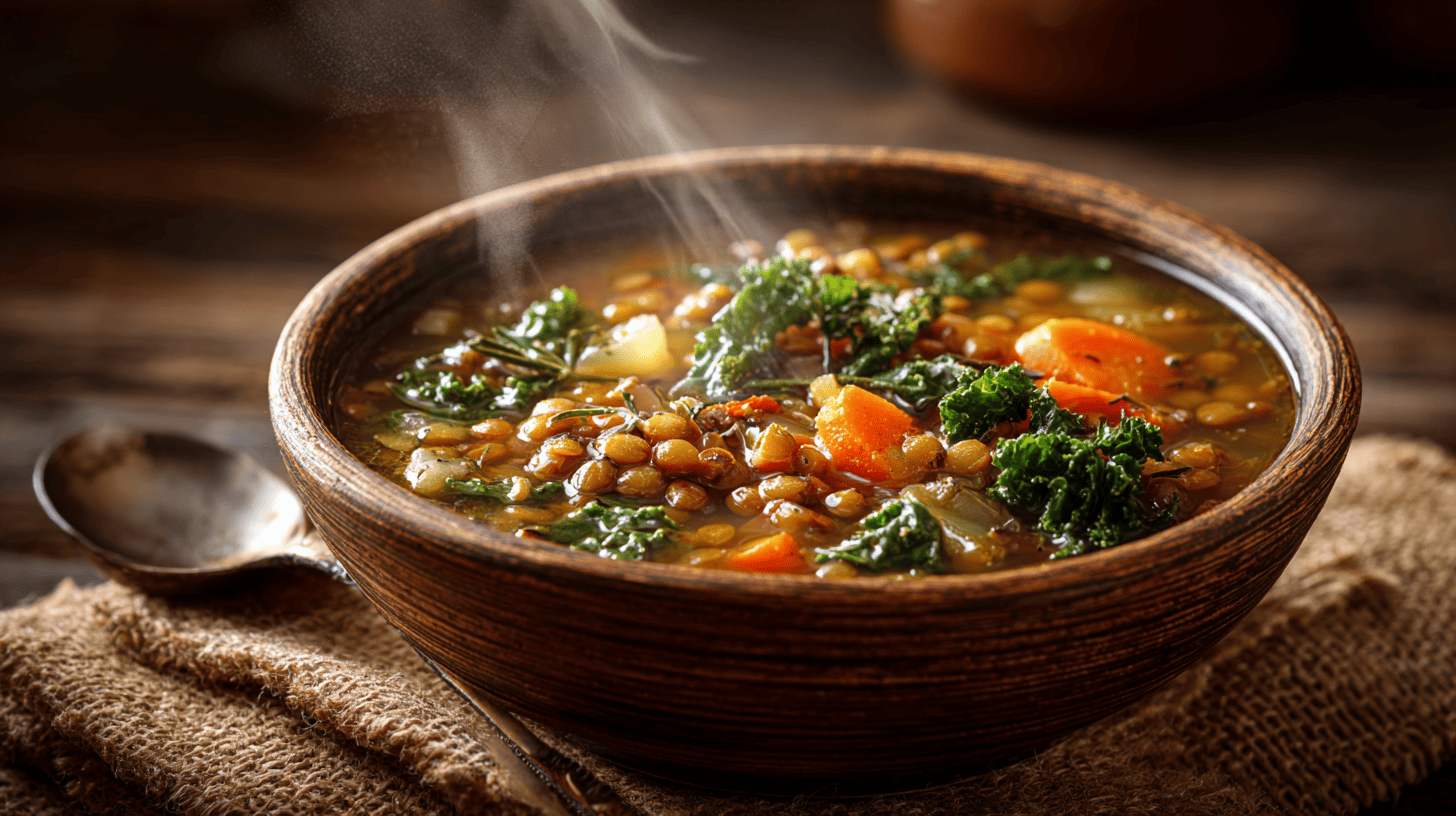
Lentils are packed with plant-based protein, fiber, and folate, which support brain health. Kale adds vitamins A, C, and K along with powerful antioxidants.
This hearty soup is filling and provides steady energy without blood sugar spikes. The combination of legumes and leafy greens makes this a perfect MIND diet meal. One pot feeds the whole family.
Ingredients: Lentils, kale, onion, garlic, broth, and herbs.
Mini Recipe: Sauté onions and garlic, add 1 cup lentils, 4 cups broth, and chopped kale. Simmer for 25 minutes, or until the lentils are tender. Season with herbs and spices.
12. Stuffed Bell Peppers with Brown Rice and Chickpeas
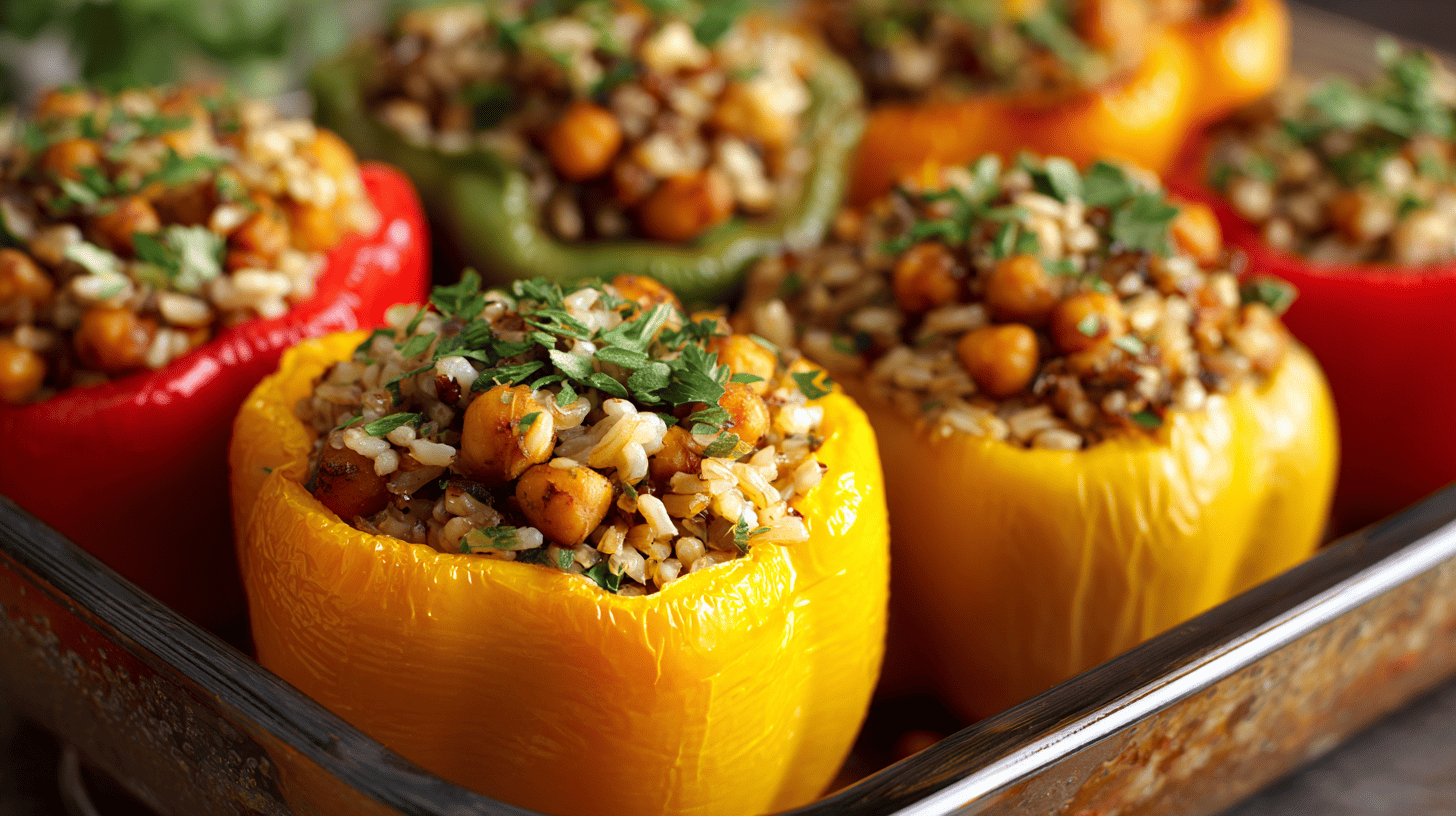
Colorful bell peppers are rich in vitamin C and antioxidants that help protect brain cells. Brown rice offers whole grain nutrition and steady energy while chickpeas add protein and fiber.
This vegetarian meal is satisfying and nutritious. The bright colors make it appealing to kids and adults alike. These can be made ahead and reheated for easy weeknight dinners.
Ingredients: Bell peppers, brown rice, chickpeas, olive oil, and herbs.
Mini Recipe: Cook brown rice and chickpeas with herbs. Cut the tops off bell peppers, remove seeds, and stuff with rice mixture. Bake at 375°F for 30 minutes, or until the peppers are tender.
13. Tofu Stir-Fry with Bok Choy and Carrots (in Olive Oil)
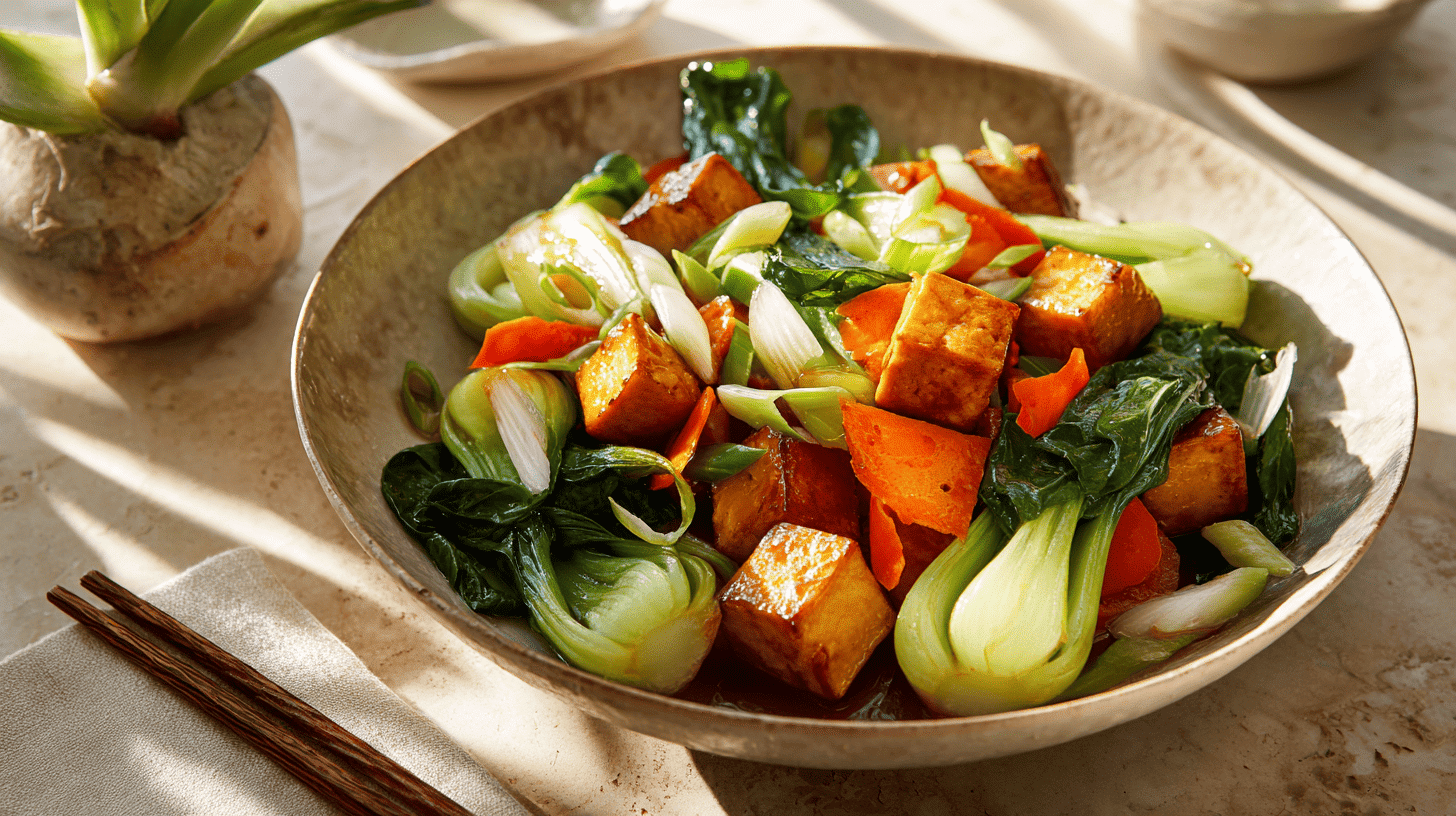
Tofu provides plant-based protein and isoflavones that may support brain health. Bok choy is rich in vitamin K and calcium, while carrots add beta-carotene.
Cooking in olive oil provides healthy monounsaturated fats that help nutrient absorption. This quick stir-fry takes just under 15 minutes to prepare. The colorful vegetables make it visually appealing and nutritious.
Ingredients: Firm tofu, bok choy, carrots, olive oil, garlic, ginger, and soy sauce.
Mini Recipe: Cube firm tofu and stir-fry in olive oil until golden. Add sliced bok choy and carrots, cook 3-4 minutes. Season with garlic, ginger, and soy sauce.
14. Mediterranean Chickpea Salad with Olive Oil and Herbs

Chickpeas provide protein, fiber, and folate in this refreshing no-cook meal. Extra virgin olive oil delivers healthy fats and antioxidants that support brain function.
Fresh herbs, such as parsley and mint, add flavor and nutrients. This salad tastes even better after sitting for a few hours as flavors blend together. It works great for meal prep and packed lunches.
Ingredients: Chickpeas, cucumber, tomatoes, red onion, olive oil, lemon juice, and herbs.
Mini Recipe: Mix cooked chickpeas with diced cucumber, tomatoes, and red onion. Dress with olive oil, lemon juice, and fresh herbs. Season with salt and pepper to taste.
15. Grilled Chicken with Sweet Potato Mash and Asparagus
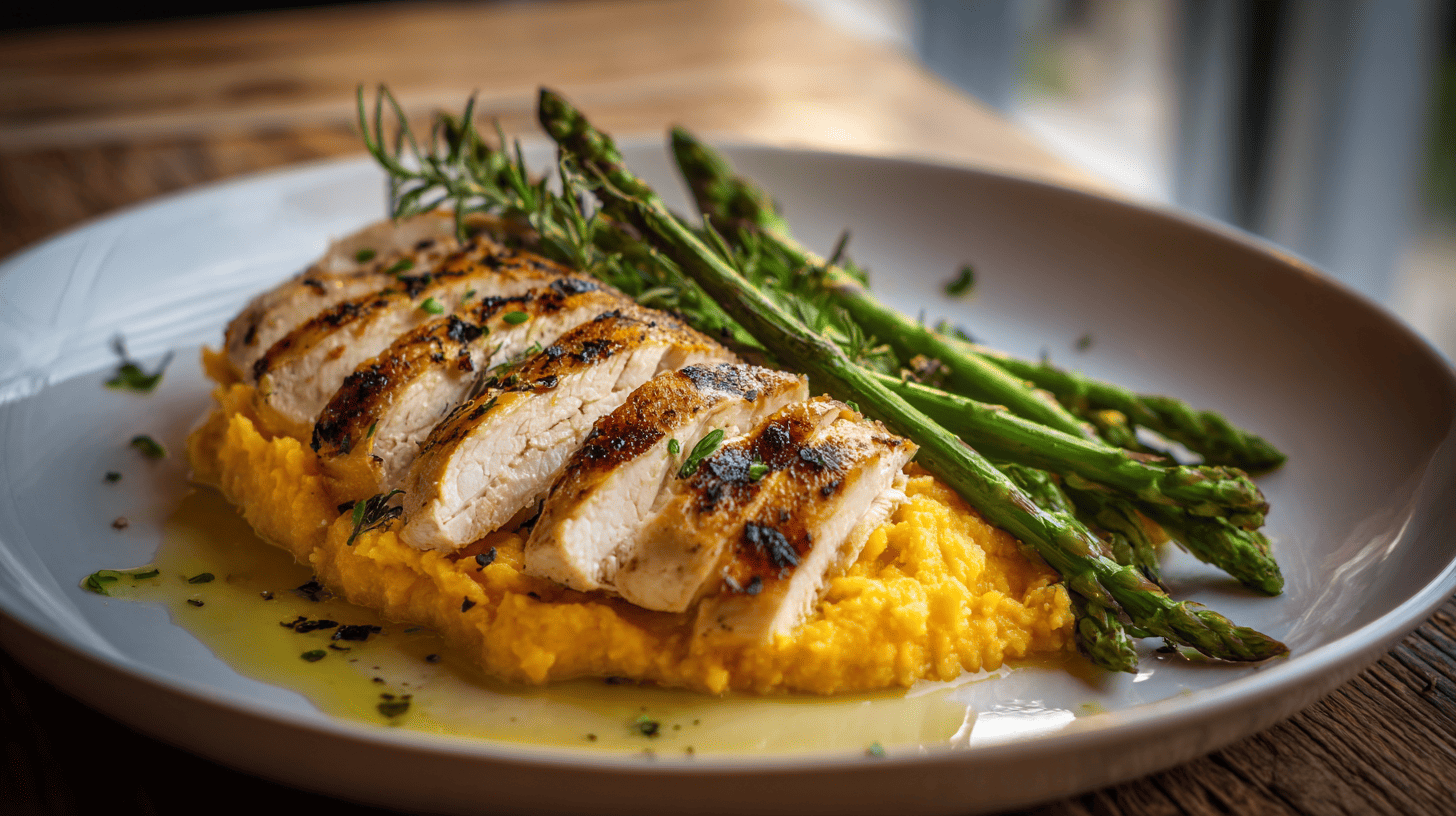
Lean chicken provides high-quality protein that helps build neurotransmitters for brain function. Sweet potatoes offer beta-carotene and fiber with a lower glycemic index than regular potatoes.
Asparagus adds folate and vitamin K. This balanced meal provides a combination of protein, healthy carbohydrates, and vegetables. The natural sweetness of the potatoes makes them a kid-friendly option.
Ingredients: Chicken breast, sweet potatoes, asparagus, olive oil, and milk (for mash).
Mini Recipe: Grill seasoned chicken breast for 6-7 minutes per side. Mash cooked sweet potatoes with a little milk. Steam asparagus until tender and serve together.
16. Quinoa and Black Bean Power Bowl with Avocado
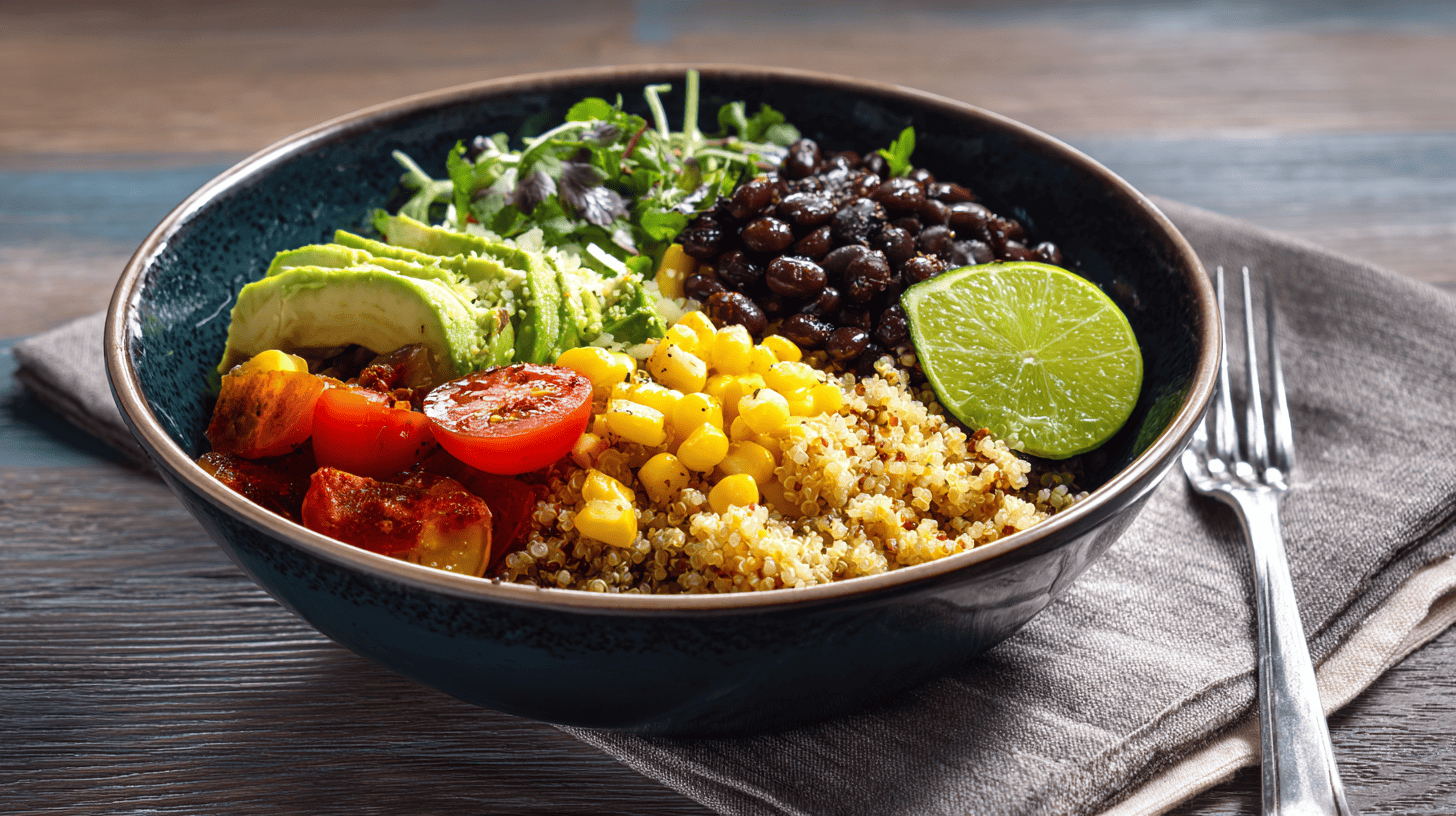
This plant-based bowl combines complete protein from quinoa with fiber-rich black beans. Avocado provides healthy monounsaturated fats that help brain function.
The combination keeps you full for hours while providing a steady energy boost. Add colorful vegetables for an extra boost of nutrients and antioxidants. This customizable bowl works for lunch or dinner.
Ingredients: Quinoa, black beans, avocado, tomatoes, corn, lime juice, and olive oil.
Mini Recipe: Layer cooked quinoa and black beans in a bowl. Top with sliced avocado, diced tomatoes, and corn. Drizzle with lime juice and olive oil dressing.
17. Oven-Baked Cod with Spinach and Cherry Tomatoes

Cod is a lean white fish that provides protein without saturated fat. Spinach delivers folate, iron, and vitamin K for brain health.
Cherry tomatoes are rich in lycopene and vitamin C. This light meal bakes in one pan for easy cleanup. The mild flavor of cod makes it appealing to picky eaters and children.
Ingredients: Cod fillets, spinach, cherry tomatoes, olive oil, and herbs.
Mini Recipe: Place cod fillets on a baking sheet with spinach and cherry tomatoes. Drizzle with olive oil and herbs. Bake at 400°F for 12-15 minutes, or until the fish flakes easily.
18. Zucchini Noodles with Pesto and Grilled Veggies

Zucchini noodles offer a low-carb alternative to pasta, providing a nutritious option that adds vitamins and minerals. Pesto made with basil, olive oil, and nuts delivers healthy fats and antioxidants.
Grilled vegetables add fiber and a variety of colorful nutrients. This light meal won’t leave you feeling heavy or sluggish. Use a spiralizer or vegetable peeler to make the zucchini noodles.
Ingredients: Zucchini, pesto (basil, nuts, olive oil), bell peppers, and eggplant.
Mini Recipe: Spiralize 2 zucchini into noodles. Grill bell peppers and eggplant until tender. Toss zucchini noodles with homemade or store-bought pesto and grilled vegetables.
19. Whole-Grain Pasta with Tomato, Olive Oil, and Leafy Greens
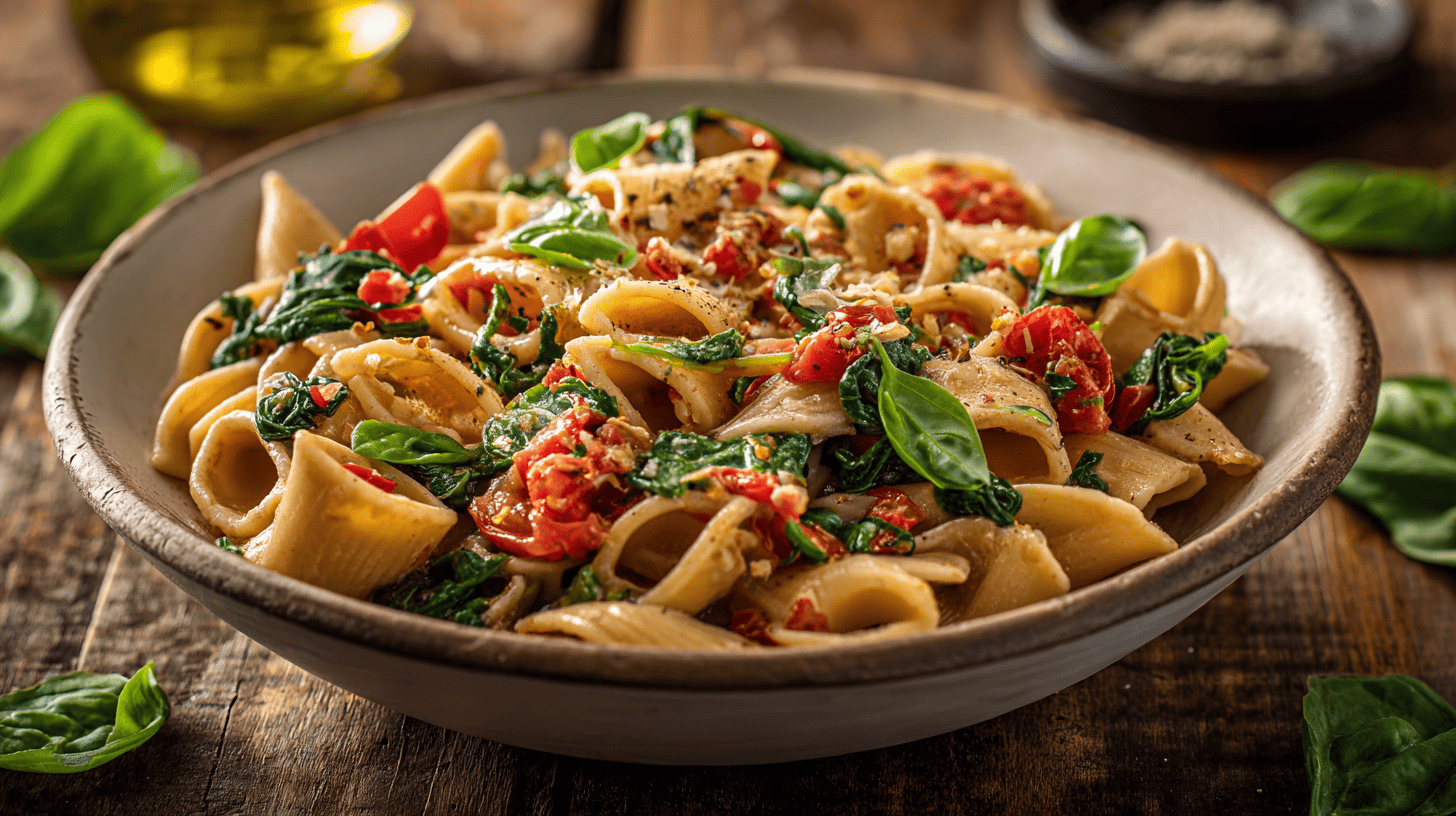
Whole-grain pasta provides fiber and B vitamins that regular pasta lacks. Tomatoes offer lycopene and vitamin C, while leafy greens add folate and iron.
Extra-virgin olive oil contributes healthy fats and helps the body absorb fat-soluble vitamins. This simple meal proves that healthy food can still be comforting. Kids love pasta, making this an easy family meal.
Ingredients: Whole-grain pasta, diced tomatoes, spinach, olive oil, garlic, and basil.
Mini Recipe: Cook whole-grain pasta according to package directions. Sauté garlic in olive oil, add diced tomatoes and spinach. Toss with cooked pasta and fresh basil.
20. Spaghetti Squash with Lentil Marinara
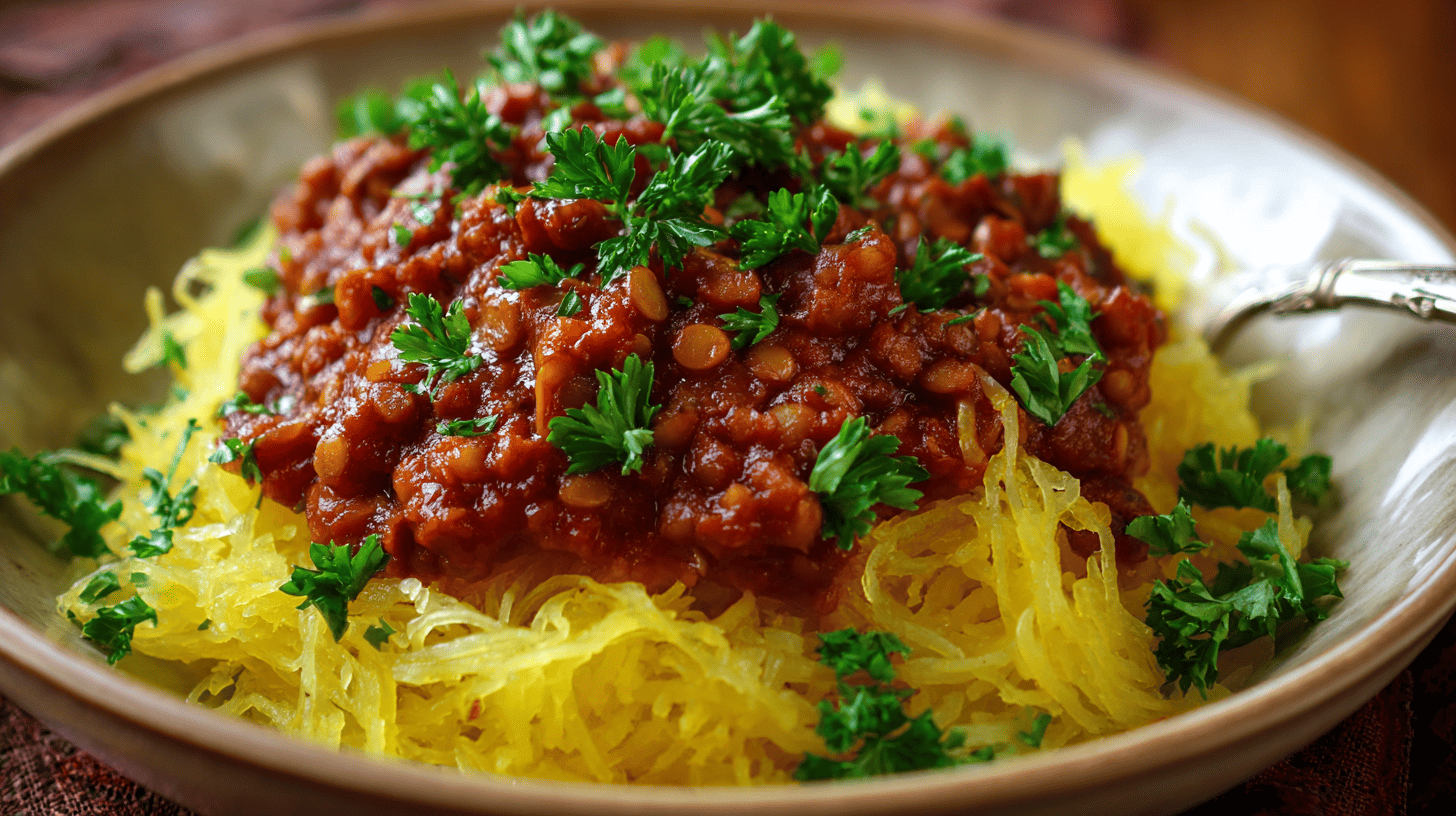
Spaghetti squash creates natural noodle-like strands while providing fewer calories and more nutrients than pasta. Lentils add protein, fiber, and folate to traditional marinara sauce.
This clever swap reduces carbs while increasing the amount of plant-based protein. The familiar flavors make it easy to accept this healthier version. One squash can feed a whole family.
Ingredients: Spaghetti squash, lentils, marinara sauce, olive oil, and herbs.
Mini Recipe: Bake a halved spaghetti squash at 400°F for 40 minutes. Simmer lentils in marinara sauce for 20 minutes. Scrape squash into strands and top with lentil sauce.
21. Vegetable & Bean Chili (Slow Cooker Friendly)

This hearty chili combines multiple types of beans to provide a complete protein and fiber. Mixed vegetables add vitamins, minerals, and antioxidants that support brain health.
The slow cooker makes this an easy, hands-off meal. Chili tastes even better the next day, as the flavors have had time to develop. Make a big batch and freeze portions for quick future meals.
Ingredients: Mixed beans, diced tomatoes, bell peppers, onions, broth, and spices.
Mini Recipe: Combine mixed beans, diced tomatoes, bell peppers, and onions in a slow cooker. Add chili powder, cumin, and broth. Cook on low for 6-8 hours, or until the vegetables are tender.
Weekly MIND Diet Plan for Brain Health & Cognition
Planning your weekly meals makes following the MIND diet easier and more enjoyable. This 7-day meal plan includes brain-healthy foods that support memory and cognitive function.
| DAY | BREAKFAST | LUNCH | SNACK | DINNER |
|---|---|---|---|---|
| Day 1 | Blueberry walnut overnight oats | Lentil and kale soup + whole grain toast | Mixed nuts | Grilled salmon, steamed broccoli, and quinoa |
| Day 2 | Spinach & mushroom omelette (olive oil) | Mediterranean chickpea salad | Carrots with hummus | Baked chicken breast, sweet potato mash & sautéed kale |
| Day 3 | Chia pudding with blueberries & flaxseeds | Quinoa bowl with black beans, spinach, and tomatoes | Orange slices & walnuts | Baked cod with roasted Brussels sprouts & brown rice |
| Day 4 | Greek yogurt parfait with raspberries & granola | Tofu stir-fry with veggies & wild rice | Frozen blueberry yogurt bites | Grilled chicken salad with greens, olive oil, & avocado |
| Day 5 | Banana oat pancakes (no sugar added) | Whole grain pasta with spinach & tomatoes | Dark chocolate (80%) + walnuts | Turkey meatballs with lentils & sautéed kale |
| Day 6 | Spinach-banana smoothie with almond butter & chia seeds | Stuffed bell peppers with quinoa & chickpeas | Cottage cheese with peaches | Grilled salmon with asparagus & barley |
| Day 7 | Oatmeal with cinnamon, blueberries & walnuts | Grilled chicken sandwich on whole grain bread with lettuce & tomato | Mixed nuts & a small orange | Veggie chili with beans, tomatoes & brown rice |
This weekly plan gives you a great starting point for the MIND diet. Feel free to swap similar foods or repeat your favorite meals. The key is including leafy greens, berries, nuts, fish, and whole grains in your daily routine.
Tips for Sticking to the MIND Diet
Following the MIND diet becomes easier with a plan and simple habits. Small daily changes can make a big difference for your brain health. Here are some practical tips to help you succeed with the MIND diet.
- Plan Your Meals Ahead of Time: Write down what you’ll eat each week to avoid unhealthy food choices.
- Add Different Brain-Healthy Foods Daily: Include leafy greens, berries, nuts, and fish in every meal.
- Cut Back on Unhealthy Fats and Sugars Slowly: Replace one junk food snack with nuts or berries daily.
- Eat Meals at the Same Times Daily: Keep regular meal times for steady blood sugar and energy.
- Keep Healthy Foods Visible: Place brain-healthy snacks where you can easily see them.
Remember that building new eating habits takes time, so be patient with yourself. Focus on adding brain-healthy foods rather than restricting everything. With practice, the MIND diet will become a natural part of your routine.
That’s a Wrap
Eating the MIND diet can be both simple and enjoyable. These mind diet recipes prove that eating for brain health can be both delicious and easy to prepare.
By including more berries, leafy greens, nuts, and fish in your meals, you’re giving your brain the nutrients it needs to stay healthy and sharp.
Begin with a few recipes that appeal to you and gradually incorporate more into your weekly routine. Your brain will thank you for making these positive changes.
Looking to keep your body and mind in top shape? Check out more blogs in our Health & Wellness section.








